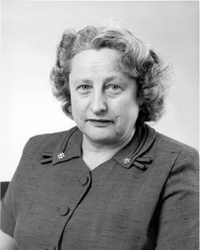Dr. Adele Turzillo (right) presents the 2025 Mary Shorb Lecture in Nutrition plaque to Dr. Leena Hilakivi-Clarke following her lecture.
Image Credit: Jonathan Stephanoff
Cancer research has come a long way in the past few decades, as have identifying genetic and environmental variables that predispose individuals to the growth and spread of tumors.
On Friday, November 7, the 2025 Mary Shorb Lecture in Nutrition was jointly presented by the departments of Animal and Avian Sciences and Nutrition and Food Science with the keynote titled “Gut dysbiosis as a mediator of increased breast cancer in female offspring born to obese mothers” presented by Dr. Leena Hilakivi-Clarke.
Dr. Hilakivi-Clark is an internationally recognized leader in women’s health and cancer prevention research with over three decades of scientific innovation and academic leadership at the University of Minnesota. With a career spanning the National Institutes of Health, Georgetown University Medical Center, and now the Hormel Institute and the Department of Food Science and Nutrition, her work has influenced our understanding of how diet, environment, and the gut microbiome influence breast cancer risk across lifetimes and generations. As a prolific scholar, mentor, and advocate for faculty development, Dr. Hilakivi-Clarke continues to advance transformative research that has resulted in more than 180 publications and the training of nearly 90 emerging scientists.
At various points in her research, Dr. Hilakivi-Clarke has examined exposure to volatile organic compounds, vehicle emissions, a specific class of contraceptives and obesity as influencers on breast cancer development. This has led her to what she describes as a two-step hypothesis of tumor formation with exposures in utero and into adult life.
It is diet and gut microbiomes that have been the focus of more recent work and the generational impacts of maternal obesity. Through a series of studies with mice, Dr. Hilakivi-Clarke and her team saw a clear increase in breast cancer rates tracked to the F3, or third, generation. Their study group was fed a high-fat/obesity-inducing diet compared to a control group. Then, both groups' offspring were fed normal diets and tracked for breast cancer development after carcinogenic exposure. Breast cancer rates were significantly higher in the study group’s offspring. The study was repeated to a second generation, or grand offspring, and then a third generation, or great-grand offspring, with fairly clear increases in cancer rates with the only variable being the great-granddam’s obesity.
Dr. Hilakivi-Clarke and her team began investigating the gut microbiome as part of this intergenerational linkage beyond genetics. They performed microbiome swaps through fecal transplants between the study and control groups’ offspring and observed increased cancer rates in the following generation. What they observed was an increased breast cancer rates in the second-generation offspring followed the maternal fecal transplants from the obese study group into the offspring of the first-generation control group.
Diet clearly plays an integral role in overall health and especially through pregnancy. Dr. Hilakivi-Clarke’s team is also looking into key aspects of diet and nutrient intake. High dietary fiber seems to have shown tumor reduction through some of their studies. During the Q/A time at the end of the lecture, Dr. Hilakivi-Clarke highlighted fiber that breaks down into short chain fatty acids like that in many fruits, vegetables and greens. Salad, anyone?
 The Lecture series is named for Mary Shaw Shorb who received her B.S. in Biology from the College of Idaho (1928) and her Sc.D. in Immunology from Johns Hopkins University (1933). In 1942, she took her first research position at the Bureau of Home Economics and Human Nutrition of the USDA at Beltsville. Two years later, she transferred to the Bureau of Dairy Industry (USDA) where she was tasked with culturing Lactobacillus lactis Dorner (LDD), which was being used to make various fermented Dairy products. The media used to grow LDD required liver extract, which led Dr. Shorb to hypothesize that LDD could be used as a rapid biological assay to identify the anti-pernicious anemia factor identified in liver, for which Minot and Murphy shared the 1934 Nobel Prize in medicine.
The Lecture series is named for Mary Shaw Shorb who received her B.S. in Biology from the College of Idaho (1928) and her Sc.D. in Immunology from Johns Hopkins University (1933). In 1942, she took her first research position at the Bureau of Home Economics and Human Nutrition of the USDA at Beltsville. Two years later, she transferred to the Bureau of Dairy Industry (USDA) where she was tasked with culturing Lactobacillus lactis Dorner (LDD), which was being used to make various fermented Dairy products. The media used to grow LDD required liver extract, which led Dr. Shorb to hypothesize that LDD could be used as a rapid biological assay to identify the anti-pernicious anemia factor identified in liver, for which Minot and Murphy shared the 1934 Nobel Prize in medicine.
After being bumped from her position at USDA in 1946 by the returning veteran who had held the position prior to the war, Dr. Shorb was given laboratory space and an unpaid appointment in the Poultry Husbandry Department of the University of Maryland. With an initial grant from Merck & Company, she developed an LDD bioassay to quantify the concentration of anti-pernicious factor in liver extracts. This assay allowed her collaborators at Merck & Company to rapidly purify and crystalize the substance they named vitamin B-12, which was rapidly proven to be therapeutically effective for pernicious anemia. She and her collaborator, Dr. Karl Folkers (Merck) were corecipients of the Mead-Johnson Award of the American Institute of Nutrition in 1949 for this work. In 1970, two years before Dr. Shorb’s retirement from the University of Maryland, Merck & Company donated $10,000 to establish a Shorb Lectureship in Nutrition to honor and perpetuate her legacy.